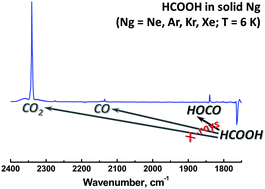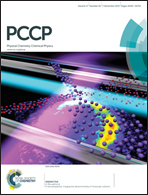Radiation-induced transformations of matrix-isolated formic acid: evidence for the HCOOH → HOCO + H channel
Abstract
The effect of X-ray irradiation on the isolated formic acid molecules (HCOOH) in solid noble gas matrices (Xe, Kr, Ar, and Ne) at very low temperatures (6 K) was first studied by FTIR spectroscopy. Carbon oxides (CO and CO2) and hydrocarboxyl radicals (HOCO) have been detected as the principal degradation products. The formation of HOCO radicals represents a primary dissociation channel for formic acid, which was not reported previously under UV photolysis in solids. This reaction can be explained by the involvement of the recombination-induced excited states, which are not populated in photolysis. The effects of the matrix and the absorbed dose on the product formation were studied in detail and possible mechanisms are discussed with particular attention to the difference between radiolysis and UV-photolysis of the matrix-isolated formic acid. The results obtained provide a new insight into the effects of high-energy impact on the simplest carboxylic acid with possible implications to the astrochemical problems, in particular, the prebiotic evolution in the interstellar medium.


 Please wait while we load your content...
Please wait while we load your content...